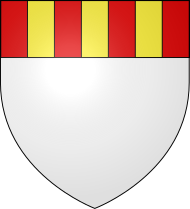Clan Keith
|
||||||||||||||||||||
|
||||||||||||||||||||
|
||||||||||||||||||||
|
||||||||||||||||||||
|
||||||||||||||||||||
|
||||||||||||||||||||
Keith is the name of a Scottish clan in Aberdeenshire and Caithness .
history
It is said that a Scottish warrior killed the Danish general Camus in the fabled Battle of Barrie in 1010. Thereupon King Malcolm II of Scotland dipped three fingers in the blood of the dead man and ran it over the warrior's shield . This man then became famous as Marbhachir Chamius or Camus Slayer (the Camus butcher ). It is alleged that after this event, the leader of the Keith Clan wore the same mark (three lines) on his arm. Today it is known that the battle and the stories it contained did not historically take place that way. Malcom's II victory at the Battle of Carham in 1018 brought him complete control of the Lothian and Berwickshire lands . The name Keith comes from the Barony of Keith in East Lothian , who was given to Marbhachir Chamius by the king for his bravery.
It is documented that Hervey de Keith held the north-eastern part of the Barony of Keith and the court office of Marshal of the King of Scotland in the 12th century . He is referred to around 1176 in an agreement with the monks of Kelso Abbey over the duty of a chapel built around 1160 on his land as Marscallus Regis Scotie . He was Marshal under William the Lion . The court office remained hereditary within his line of descendants until 1716.
The Marshals of Scotland participated intensively in the Scottish Wars of Independence. Sir Robert Keith commanded the Scottish Light Cavalry in 1314 during the Battle of Bannockburn and died in 1332 during the Battle of Dupplin Moor . His grandson Robert Keith died in the Battle of Neville's Cross in 1346 . At the end of the 14th century Sir William Keith gained control of a rocky peninsula in Kincardineshire through a land swap with Lord Lindsay . On it he had Dunnottar Castle fortified, which was owned by the Keiths until the 18th century. William Keith died around 1410.
Around 1458 Marshal William Keith († 1475) was raised as Earl Marischal to the rank of Earl . The title and office of Marshal expired in 1716 after his descendant, George Keith, 9th Earl Marischal , participated in the Jacobite Rebellion of 1715 and was ostracized for treason. He fled into exile in Prussia , where his brother James Keith (1696–1758) served as Field Marshal General and, like him, became a close confidante of Frederick the Great . The third son of the 6th Earl Marischal, Sir John Keith († 1714) was raised to Earl of Kintore in 1677 . His line of descendants carries this earl title to this day and has been the chiefs of Clan Keith since the line of Earls Marischal became extinct.
literature
- Hugh Chisholm (Ed.): Encyclopædia Britannica . 11th edition, Cambridge University Press , 1911.
- Dixon B. Homer: The Border or Riding Clans and History of Clan Dickson. Joel Munsell's Sons, Albany (New York) 1889.
- Alexander Nisbet: Nisbet's System of Heraldry. Edinburgh 1722
- Frank Adam, Thomas Innes: The Clans, Septs and Regiments of the Scottish Highlands . 1934.
- Chris Brown: Robert the Bruce, A Life Chronicled Tempus Publishing, Stroud 2004. ISBN 0-7524-2575-7 .
- Liber S. Marie de Calchou. Registrum cartarum abbacie tironensis de Kelso, 1113–1567. Bannatyne Club, Edinburgh 1846. ( archive.org )
Web links
Individual evidence
- ^ The Camus Cross . www.monikie.org.uk. Archived from the original on August 28, 2008. Retrieved September 2, 2008.
- ↑ Entry on Battle of Barry in Canmore, the database of Historic Environment Scotland (English)
- ↑ Liber S. Marie de Calchou, No. 96, pp. 70 f.

